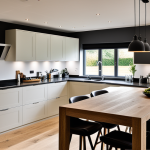Crafting a Cozy, Energy-Efficient Home in Chilly Climates: Maximize Your Heat Savings
As the winter months approach, keeping your home warm and cozy without breaking the bank becomes a top priority. Here are some expert tips to help you create an energy-efficient home that not only saves you money but also reduces your carbon footprint.
Sealed and Insulated to Perfection
One of the most critical factors in maintaining a comfortable indoor temperature is proper insulation and sealing. This is where the foundation of your energy-efficient home begins.
Topic to read : Ultimate Tips to Boost Water Efficiency in Your Home Vegetable Garden
The Importance of Insulation
Insulation is key to preventing heat loss and keeping your home warm. Advanced materials such as fiberglass, cellulose, and spray foam insulation can be used in walls, roofs, and floors to minimize heat escape. For instance, Bill Clark Homes emphasizes the use of insulated walls and roofs, along with weather-stripped doors and windows, to ensure that every detail is designed to prevent drafts and reduce energy consumption[1].
Sealing Gaps and Cracks
In addition to insulation, sealing gaps and cracks around windows, doors, and other openings is crucial. This can be done using caulk, weatherstripping, or spray foam. Here’s a detailed list of areas to focus on:
Also to see : Unlock Skylight Potential: Best Tips for Boosting Natural Heating Efficiency
- Windows and Doors: Use weatherstripping or door sweeps to seal gaps.
- Electrical Outlets and Switches: Use foam gaskets to seal gaps around these fixtures.
- Pipes and Ducts: Insulate exposed pipes and ducts in unheated areas like the basement or attic.
- Attic Hatches: Ensure attic hatches are well-insulated and sealed.
- Foundation: Seal any cracks in the foundation to prevent cold air infiltration.
By addressing these areas, you can significantly reduce heat loss and keep your home warm without overusing your heating system.
High-Performance Windows
Windows are a significant source of heat loss in many homes, especially older ones. Upgrading to high-performance windows can make a substantial difference in your home’s energy efficiency.
Features of High-Performance Windows
When looking for the best insulated windows for cold weather, consider the following features:
- Triple-Pane Glass: Provides superior insulation compared to single-pane windows[2].
- Low-Emissivity (Low-E) Coatings: Reflects heat back into the room while letting natural light in, reducing energy consumption[2].
- Warm-Edge Spacers: Reduces heat transfer at the edges of the glass, minimizing condensation and heat loss[2].
- Durable Window Frames: Vinyl frames are excellent options for withstanding harsh conditions of cold climates[2].
For example, Vector Windows’ Envision series offers triple-pane glass, warm-edge spacers, and durable frames, making them an ideal choice for cold climates[2].
Energy-Efficient Heating Systems
Your heating system is the heart of your home’s warmth during winter. Choosing an energy-efficient system can help you save significantly on your energy bills.
Heat Pumps: A Modern Solution
Heat pumps are becoming increasingly popular for their efficiency and environmental benefits. Here’s how they work:
- Cold-Climate Heat Pumps: Operate down to -30°C and can replace gas furnaces altogether. However, they can be expensive[3].
- Hybrid Systems: Work down to about -10°C and then switch to a furnace for extremely cold days. These are more affordable but still highly efficient[3].
A homeowner who installed an electric heat pump shared their experience: “Since my wife and I installed an electric heat pump and a high-efficiency electric water heater, we’ve used a total of 20 cubic meters of natural gas, the total cost of which came out to $4.25—the same amount I spend on a coffee each day at a nice cafe up the block from my house at lunch time.”[3]
Programmable Thermostats
Programmable thermostats are another way to optimize your heating system. These thermostats allow you to control heating schedules to match your lifestyle, ensuring warmth when you need it and savings when you don’t.
LED Lighting and Other Energy-Saving Features
While heating is a major concern, other aspects of your home can also contribute to energy efficiency.
LED Lighting
LED lighting is a simple yet effective way to save energy. Here are some benefits:
- Longer Lifespan: LED bulbs last longer than traditional incandescent bulbs.
- Energy Efficiency: Use significantly less energy than traditional options[1].
- Cost Savings: Over time, LED bulbs can save you money on your energy bills.
Energy-Efficient Appliances
Using energy-efficient appliances can further reduce your energy consumption. Look for appliances with the ENERGY STAR® rating, which ensures they meet energy efficiency standards.
Built for Sustainability
Creating an energy-efficient home is not just about saving money; it’s also about reducing your carbon footprint.
Solar Panels and Renewable Energy
Consider integrating solar panels into your home energy system. Here’s a comparison of the benefits:
| Feature | Solar Panels | Traditional Energy |
|---|---|---|
| Energy Source | Renewable (Sunlight) | Non-Renewable (Fossil Fuels) |
| Energy Costs | Potential for zero energy costs | Ongoing energy bills |
| Environmental Impact | Zero emissions | Contributes to greenhouse gas emissions |
| Maintenance | Low maintenance | Higher maintenance costs |
Energy Audits and Retrofits
Conducting an energy audit can help you identify areas where your home can be more energy-efficient. Here’s what one homeowner learned from their energy audit:
“We signed up for an energy audit with an eye to taking advantage of retrofit grants. The auditor suggested more insulation, stopping up drafts, and an electric water heater; the other retrofits seemed too costly.”[3]
Practical Tips to Reduce Your Energy Bills
Here are some practical tips to help you reduce your energy bills and make your home more energy-efficient:
Adjust Your Thermostat
- Lower your thermostat by 1-2 degrees when you’re not home or sleeping to save energy.
- Use a smart thermostat to automate temperature adjustments.
Use Passive Heating
- Open curtains or blinds on sunny days to let natural light warm your home.
- Close them at night to retain the heat.
Insulate Your Radiators
- Use radiator reflectors to reflect heat back into the room instead of letting it escape through walls.
Seal Your Windows and Doors
- Use draft stoppers or weatherstripping to seal gaps around windows and doors.
Upgrade to Energy-Efficient Windows
- Consider replacing old windows with high-performance, insulated windows.
Creating a cozy, energy-efficient home in chilly climates requires a combination of the right materials, efficient systems, and practical habits. Here are some final tips to help you get started:
- Invest in Proper Insulation: Ensure your home is well-insulated to prevent heat loss.
- Choose High-Performance Windows: Upgrade to windows with features like triple-pane glass and Low-E coatings.
- Opt for Energy-Efficient Heating Systems: Consider heat pumps or hybrid systems for efficient heating.
- Use LED Lighting: Replace traditional bulbs with LED bulbs to save energy.
- Conduct an Energy Audit: Identify areas for improvement and take advantage of retrofit grants.
By following these tips, you can make your home not only warmer but also more energy-efficient, saving you money on your energy bills and reducing your environmental impact.
Additional Resources
For those looking to delve deeper, here are some additional resources:
- Energy Star Website: Provides detailed information on energy-efficient products and practices.
- Local Energy Audits: Many utilities and government programs offer free or discounted energy audits.
- Home Improvement Stores: Often offer workshops and advice on energy-efficient home improvements.
By taking the time to implement these strategies, you can create a home that is both cozy and energy-efficient, ready to handle the cold winter months while keeping your energy bills manageable.






